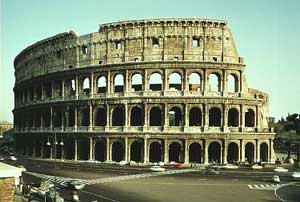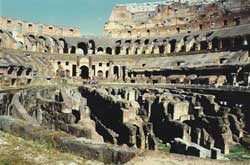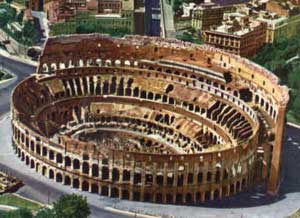Colisée Arena
 In ancient Roman times, Rome had a period of prosperity lasting several centuries from 27 BC to 476 AD. Architectural and construction achievements are focused on this period. Romans have a pragmatic mind, focusing on function, favoring superficiality. Their architecture has a large form that satisfies the various functions of use, while the streets and bridges are flat and durable.
In ancient Roman times, Rome had a period of prosperity lasting several centuries from 27 BC to 476 AD. Architectural and construction achievements are focused on this period. Romans have a pragmatic mind, focusing on function, favoring superficiality. Their architecture has a large form that satisfies the various functions of use, while the streets and bridges are flat and durable.
The most typical architectural work is often mentioned first in Ancient Roman architecture, which can be considered as the first representation of Ancient Roman civilization, the Colisée arena.
Colisée Arena in Rome started in 72 AD (in the reigns of Vespasien and Tittus), is a physical work but fully reflects the spiritual life of the ancient Romans. At that time, the Romans enjoyed watching beasts, wrestling between people and beasts, and horse racing and other fun games.
 Circence games - many of which have to be replaced by many human blood - are considered an equally necessary need for bread (Panem). Therefore, the King built many schools (Xiechut), and Colisée arena was a large ancient building of this type. In terms of absolute size and capacity, it is only inferior to Maximux church (600m long, 200m wide containing 26,000 people) but in terms of complexity of the function, aesthetic structure, it is somewhat more.
Circence games - many of which have to be replaced by many human blood - are considered an equally necessary need for bread (Panem). Therefore, the King built many schools (Xiechut), and Colisée arena was a large ancient building of this type. In terms of absolute size and capacity, it is only inferior to Maximux church (600m long, 200m wide containing 26,000 people) but in terms of complexity of the function, aesthetic structure, it is somewhat more.
Located between the Caesar Square and Rome, the building's surface is elliptical with a circumference of 527m, divided into four symmetrical parts by two long and short axes, the long axis measuring 188m, short axis of size 156m.
Colisée's elliptical coliseum was gradually raised, organized in the form of an Amphitheater slope and contained 50,000 people including 45,000 seats and 500 seats . The first audience was 5 meters taller than the stadium to ensure safety for viewers, while the final audience had a height of 5 stories. The number of seats running from bottom to top has up to 60 rows, divided into 5
 the area in height, separately escapes people into their exits and stairs. The whole building has 80 such exits, while the King has a private entrance attached to the underground road, ensuring a short path between the honor seat in the stands with the Royal Palace. Under the stands there are space systems for resting and running around three floors.
the area in height, separately escapes people into their exits and stairs. The whole building has 80 such exits, while the King has a private entrance attached to the underground road, ensuring a short path between the honor seat in the stands with the Royal Palace. Under the stands there are space systems for resting and running around three floors.
The form of the Colisée arena is faithfully reflected on the façade, the whole building is 48m high, only 3 floors use the stone rolling structure, from the bottom up to use the column of Dichrich, Ionic and Coranh, changing from heavy to light, then another fourth floor uses the main solid array, occasionally making small windows and decorating the flags to match the atmosphere of the festival.
The building has a majestic style thanks to its large size and exaggerated look of the arches from the floors. Architectural details are also noticed to create a dramatic atmosphere in the arena. The inner field is a rectangle of 86x64m.

The whole architecture is in Rome around Colisée Arena
Colisée Arena has a complete structural system , the column wall system runs around the facade of the building to create 80 stone arches along with a fanless horizontal wall system - 80 pieces - to support all the stands and floor of the building. Not only is the system of rational structure but also the selection of materials has shown that the ancient Romans mastered some important construction techniques. The form of structure on the outside of the arena used two very successful rolling and pillar elements.
Although the Colisée arena is no longer intact, a part has been lost, but its position and significance for Rome are not reversed.
- Discovered the ancient Roman arena with a capacity of 10,000 people
- Discover the miniature Colosseum arena of the Roman emperor
- Things you didn't know about the Colosseum
- Discover the Roman arena in Austria
- Video: Arena scene of pitbull dog death fighting bloody wild boar
- GameVui - A part of the lives of young people
- Found erotic paintings from Roman times
- Yahoo 'scratches and flakes' on the cellphone arena
- Sophus Lie: Unfortunate genius
- Phu Quoc Dog: Legend and truth
- How much is the world 'wonder' worth?
- The Colosseum subsided 38cm
 Norway built the world's tallest wooden tower
Norway built the world's tallest wooden tower Kremlin
Kremlin Ashurbanipal: The oldest royal library in the world
Ashurbanipal: The oldest royal library in the world Decoding the thousand-year construction of Qin Shihuang shocked the world
Decoding the thousand-year construction of Qin Shihuang shocked the world